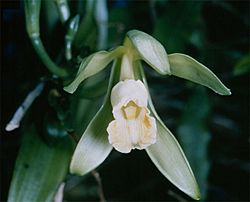Vanilla facts for kids
Quick facts for kids Vanilla |
|
|---|---|
 |
|
| Vanilla planifolia | |
| Scientific classification | |
| Kingdom: | |
| Division: | |
| Class: | |
| Order: | |
| Family: | |
| Subfamily: | |
| Tribe: |
Vanilleae
|
| Subtribe: |
Vanillinae
|
| Genus: |
Vanilla
|
Vanilla is a popular spice and a flavoring. It comes from a special plant called the Vanilla orchid, which grows like a vine.
The most common type of vanilla plant used for flavoring is called Vanilla planifolia. A Spanish explorer named Hernán Cortés is believed to have brought vanilla and chocolate to Europe in the 1520s.
Today, much of the vanilla flavor we use is made in laboratories. This man-made version of the flavor is known as 'vanillin'.
Contents
History of Vanilla
Vanilla was first brought to Europe by the Spanish in the 1520s. It was already a very important spice in an area called Mesoamerica, which is now parts of Mexico and Central America.
Early Growers: The Totonac People
The very first people to grow vanilla were the Totonac people. They lived on the eastern coast of Mexico. The Totonac people have a story that says the vanilla plant grew from the spot where a royal princess and her lover were sadly killed.
Aztecs and Vanilla
In the 15th century, the Aztecs fought against the Totonacs and won. The Aztecs really liked the taste of vanilla. They called the vanilla fruit tlilxochitl, which means "black flower." This name came from how the vanilla fruits turn black and dry after they are picked.
Vanilla Spreads Around the World
For a long time, Mexico was the biggest producer of vanilla. But in 1819, some French business people sent vanilla plants to the islands of Réunion and Mauritius. They hoped to grow vanilla there.
However, the vanilla plants did not grow well at first. This was because these islands did not have the right kind of bees to carry pollen between the flowers. This process is called pollination.
Then, a young slave named Edmond Albius made an amazing discovery. He figured out how to pollinate the vanilla flowers quickly by hand! After this, vanilla started to grow very well in these new places.
Soon, vanilla plants were sent from Réunion Island to the Comoros Islands and to Madagascar. By 1898, Madagascar, Réunion, and the Comoros Islands were producing about 80% of all the vanilla in the world. That was about 200 metric tons of vanilla fruits!
Vanilla Prices Over Time
The price of vanilla has changed a lot over the years. In the late 1970s, the price went up very high. This happened after a big storm damaged important vanilla farms. Prices stayed high for a few years.
Later, the price dropped a lot, to about US$20 for one kilogram. In 2000, prices went up sharply again after another big storm hit Madagascar. Bad weather and other problems made vanilla prices go up to US$500 for one kilogram in 2004. But by 2005, the price went down again to about $40 for one kilogram. By 2010, it was around US$20 for one kilogram.
Where Vanilla is Grown Today
Today, most of the vanilla known as Bourbon vanilla is grown in Indonesia. Madagascar also grows a lot of vanilla. Mexico, which used to be the biggest producer, now grows much less. For example, in 2006, Mexico only made 10 tons of vanilla, compared to 500 tons in earlier years.
About 95% of "vanilla" flavored foods actually use man-made vanillin. This vanillin can be made from lignin, which is a natural material found in wood.
Images for kids
-
Vanilla plantation in a wood
-
A drawing of the Vanilla plant from an old book called the Florentine Codex (around 1580). It also describes how it was used in the Nahuatl language.
-
Vanilla rum from Madagascar.
See also
 In Spanish: Vanilla planifolia para niños
In Spanish: Vanilla planifolia para niños













